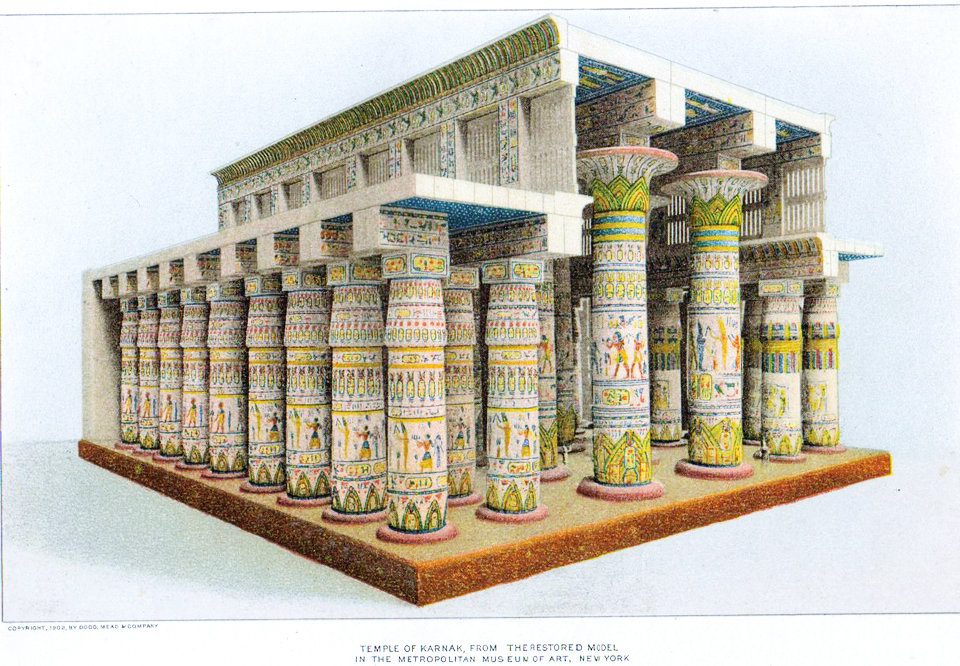Hypostyle


In architecture, a hypostyle hall has a roof which is supported by columns.
Etymology
The word hypostyle comes from the Ancient Greek ὑπόστυλος hypóstȳlos meaning “under columns” (where ὑπό hypó means below or underneath and στῦλος stŷlos means column).
Construction
The hypostyle is transverse to the longitudinal axis of the temple and consists of an inflated central nave and two lower aisles . The ceiling of a hypostyle is flat.
The central nave forms the passage from the forecourt into the interior of the temple, but in many temples the hypostyle is followed by a second pillared hall. This passage is flanked on both sides by a row of pillars each, the columns of which are higher and have a larger diameter than those of the aisles. In the upper part of the walls of the central nave are large ridge windows, which are usually the only light source of the Hypostyle.
In the aisles are several rows of columns with lower, slimmer columns, which are arranged transversely to the longitudinal axis of the temple. Due to the sparse incidence of light in the Hypostyl, the impression of an unlimited all-round pillar forest is created, especially in larger temples.
Symbolism
In the representation of the microcosm of creation through the Egyptian temple itself the hypostyle symbolized the reed marsh around the primeval mound . The use of papyrus capitals enhanced the viewer’s impression of being in a forest of plants. In the Amun temple of Karnak , this symbolism was further developed by raising the 137 pillars on bases reminiscent of the earth around the roots of papyrus plants. The large columns along the central axis are 23 m high and end in wide open papyrus capitals, the remaining columns in closed papyrus capitals. Also in the Khnum Temple of Esnathe swamp symbolism was strengthened by depicting insects on the pillar capitals. The architraves on the pillars and the ceiling represented the sky.
Profanbau
The higher grades in Egypt also used Hypostyl in their homes. Just as in the temple, attention was paid to a traditionally determined spatial sequence. Over the main courtyard one came into an open pillared hall, which was adjoined by a transversely arranged reception hall. The following main room was usually erected in the form of a four-column hypostyle room.
Technical options
The roof may be constructed of with bridging lintels of stone, wood or other rigid material such as cast iron, steel or reinforced concrete. There may be a ceiling. The columns may be all the same height or, as in the case of the Great Hypostyle Hall at Karnak, the columns flanking the central space may be of greater height than those of the side aisles, allowing openings in the wall above the smaller columns, through which light is admitted over the aisle roof, through clerestory windows.
Applications
The architectural form has many applications, occurring in the cella of Ancient Greek temples and in many Asian buildings, particularly of wood construction.
Egyptian temple
In the Egyptian temples, the hypostyle hall was the room beyond the hypoperal hall and anterior to the following pieces, each time more recondite. The hypostyle hall no longer had access to the town, but the aristocracy did; that he could not continue to the following zones, reserved exclusively for the pharaoh and the priests (the latter is usually called sanctum sanctorum by comparison to the Temple of Jerusalem).
The most studied is the great hypostyle hall of the temple of Amun in Karnak . On a rectangular plant (comparable to the Roman and early Christian “basilical” plant), it consists of a central nave of greater height flanked by two lateral naves; all supported by columns of papyriform capitals. It receives a light illumination through superior lattices of the central ship, being the lateral ones perpetually in the shade. It is an innovation of the 19th Dynasty , and symbolizes the concept of creation: the room represents the primordial marsh ( Noun) from which emerge the stems of the papyrus or lotus plants (represented by the columns and their capitals). Light (also a divine concept) causes the plants that receive it (the columns of the central nave) to develop more than those that remain in darkness. The temples of the Ramesses repeat this model ( Ramesseum , Khonsu temple in Karnak, temple of Amon in Luxor , temple of Ptah in Memphis , temple of the millions of years in Medinet Habu , temple of Bastet in Bubastis , temple of Toth in Hermopolis ). In the Late Periodthe model is abandoned, but the hypostyle rooms continue to appear in Ptolemaic and Roman buildings (temple of Hathor in Dendera , temple of Khnoum in Esna , temple of Horus in Edfu , temple of Kom Ombo ).
Mosques
With a combination of columns and arches, the hypostyle hall became one of the two main types of mosque construction. In many mosques, especially the early congregational mosques, the prayer hall has the hypostyle form. One of the finest examples of the hypostyle-plan mosques is the Great Mosque of Kairouan (also called the Mosque of Uqba) in the city of Kairouan, Tunisia.
Modern
The hypostyle is widely used in modern architecture.
Source From Wikipedia